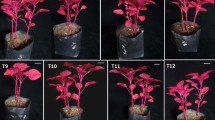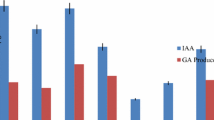Abstract
In the present investigation, the effect of three beneficial organisms (root endophytic fungus Piriformospora indica (Pi) and pseudomonads strains R62 and R81) and their four different consortia (Pi+R62, Pi+R81, R62+R81, Pi+R62+R81) was investigated on the plant Vigna mungo through their inorganic carrier-based (talcum powder and vermiculite) formulations. All the treatments resulted in significant increase in growth parameters under glasshouse as well as field conditions and showed a consistency in their performance on moving from glasshouse to field conditions. In glasshouse conditions, a maximum increase of 4.5-fold in dry root weight and 3.9-fold in dry shoot weight compared to control was obtained with vermiculite-based consortium formulation of Pi+R81. In field studies using vermiculite as carrier, a maximum enhancement of 3.2-fold in dry root weight, 3.0-fold in dry shoot weight, 8.4-fold in number of nodules and 4.0-fold in number of pods in comparison to control was obtained with the bio-inoculant formulation containing consortium of Pi+R81. The same treatment also caused the highest improvement of 1.9-fold in nitrogen content and 1.7-fold in phosphorus content, while the highest increase of 1.4-fold in potassium content was obtained with Pi alone.

Similar content being viewed by others
References
Allen SE, Grimshaw HM, Parkinson JA, Quarmby C (1974) Chemical Analysis of ecological materials. Blackwell, Oxford
Aragno M, Schlegel HG (1991) The mesophilic hydrogen-oxidizing (knallgas) bacteria. In: Balows A, Trüper HG, Dworkin M, Harder W, Schleifer KH (eds) The prokaryotes, 2nd edn. Springer, Berlin, pp 344–384
Barea JM, Andrade G, Bianciotto V, Dowling D, Lohrke S, Bonfante P, O’Gara F, Azco′n-Aguilar C (1998) Impact on arbuscular mycorrhiza formation of Pseudomonas strains used as inoculants for biocontrol of soilborne fungal plant pathogens. Appl Environ Microbiol 64:2304–2307
Bashan Y (1998) Inoculants of plant growth promoting bacteria for use in agriculture. Biotechnol Adv 16:729–770
Bashan Y, Levanony H (1988) Adsorption of the rhizosphere bacterium Azospirillum brusilense Cd to soil, sand and peat particles. J Gen Microbiol 134:1811–1820
Biro B, Koves-Pechy K, Voros I, Takacs T, Eggenberger P, Strasser RJ (2000) Interrelations between Azospirillum and Rhizobium nitrogen-fixers and arbuscular mycorrhizal fungi in the rhizosphere of alfalfa in sterile, AMF-free or normal soil conditions. Appl Soil Ecol 15:159–168
Chapman HD, Pratt PF (1978) Methods of analysis for soils and waters. University of California, Division of Agriculture Science, CA
Gaur R, Shani N, Kawaljeet K, Johri BN, Rossi P, Aragno M (2004) Diacetylphloroglucinol-producing pseudomonads do not influence AM fungi in wheat rhizosphere. Curr Sci 86:453–457
Gomez KA, Gomez AA (1984) Statistical procedures for agricultural research. Wiley, New York
Jackson ML (1973) Soil chemical analysis. Prentice-Hall, Englewood Cliffs
Jansiewicz WJ (1988) Bioccontrol of post harvest diseases of apples with antagonist mixtures. Phytopathol 78:194–198
King JV, Campbell JJR, Eagles BA (1948) The mineral requirements for fluorescin production. Can J Res 26c:514–519
Kumar V, Sahai V, Bisaria VS (2011) High-density spore production of Piriformospora indica, a plant growth-promoting endophyte, by optimization of nutritional and cultural parameters. Bioresour Technol 102:3169–3175
Lynch JM (1990) The rhizosphere. Chichester
Mäder P, Kaiser F, Adholeya A, Singh R, Uppal HS, Sharma AK, Srivastava R, Sahai V, Michel M, Wiemken A, Johri BN, Fried PM (2011) Inoculation of root microorganisms for sustainable wheat-rice and wheat-black gram rotations in India. Soil Biol Biochem 43:609–619
Nakkeeran S, Dilantha FWG, Sidduqui ZA (2005) Plant growth promoting rhizobacteria formulations and its scope in commercialization for the management of pests and diseases. In: Siddiqui ZA (ed) PGPR: biocontrol and biofertilization. Springer, Netherlands, pp 257–296
Oelmüller R, Sherameti I, Tripathi S, Varma A (2009) Piriformospora indica, a cultivable root endophyte with multiple biotechnological applications. Symbiosis 49:1–17
Podila GK, Varma A (2004) Basic research and applications of mycorrhizae. Microbiology Series. IK International, India, pp 259–287
Podile AR, Kishore GK (2006) Plant growth promoting rhizobacteria. In: Gnanamanickam SS (ed) Plant-associated bacteria. Springer, Amsterdam, pp 195–230
Prasad R, Pham HG, Kumari R, Singh A, Yadav V, Sachdev M, Garg AP, Peskan T, Hehl S, Sherameti I, Oelmüller R, Varma A (2005) Sebacinaceae: culturable mycorrhiza-like endosymbiotic fungi and their interaction with non-transformed and transformed roots. In: Declerck S, Strullu DG, Fortin A (eds) In vitro culture of mycorrhizas, soil biology, vol 4. Springer, Berlin, pp 291–312
Roesti D, Gaur R, Johri BN, Imfeld G, Sharma S, Kawaljeet K, Aragno M (2006) Plant growth stage, fertilizer management and bio-inoculation of Arbuscular mycorrhizal fungi and plant growth promoting rhizobacteria affect the rhizobacterial community structure in rain-fed wheat fields. Soil Biol Biochem 38:1111–1120
Russo A, Felici C, Toffanin A, Gotz M, Collados C, Barea JM, Moenne-Loccoz Y, Smalla K, Vandeleyden J, Nuti M (2005) Effect of Azospirillum inoculants on arbuscolar mycorrhiza establishment in wheat and maize plants. Biol Fertil Soils 41:301–309
Saharan K, Sarma MVRK, Srivastava R, Sharma AK, Johri BN, Prakash A, Sahai V, Bisaria VS (2010) Development of non-sterile inorganic carrier-based formulations of fluorescent pseudomonad R62 and R81 and evaluation of their efficacy on agricultural crops. Appl Soil Ecol 46:251–258
Saharan K, Sarma MVRK, Prakash A, Johri BN, Bisaria VS, Sahai V (2011) Shelf-life enhancement of bio-inoculant formulation by optimizing the trace metals ions in the culture medium for production of DAPG using fluorescent pseudomonad R62. Enzyme Microb Technol 48:33–38
Saleh SA, Mekhemar GAA, Abo El-Soud AA, Ragab AA, Mikhaeel FT (2001) Survival of Azorhizobium and Azospirillum in different carrier materials: inoculation of wheat and Sesbania rostrata. Bull Fac Agric Univ Cairo 52:319–338
Sarma MVRK, Sahai V, Bisaria VS (2009) Genetic algorithm based medium optimization for enhanced production of fluorescent pseudomonad R81 and siderophores. Biochem Eng J 47:100–108
Sarma MVRK, Kumar V, Saharan K, Srivastava R, Sharma AK, Prakash A, Sahai V, Bisaria VS (2011) Application of inorganic carrier-based formulations of fluorescent pseudomonads and Piriformospora indica on tomato plants and evaluation of their efficacy. J Appl Microbiol. doi:10.1111/j.1365-2672.2011.05062.x
Sharma A, Johri BN, Sharma AK, Glick BR (2003) Plant growth-promoting bacterium Pseudomonas sp. strain GRP3 influences iron acquisition in mung bean (Vigna radiata L. Wilzeck). Soil Biol Biochem 35:887–894
Smith SE, Read DJ (1997) Mycorrhizal symbiosis. Academic Press, London
Varma A, Singh A, Sudha S, Sahay NS, Sharma J, Roy A, Kumari M, Rana D, Thakran S, Deka D, Bharti K, Franken P, Hurek T, Blechert O, Rexer K-H, Kost G, Hahn A, Hock B, Maier W, Walter M, Strack D, Kranner I (2001) Piriformospora indica: a cultivable mycorrhiza-like endosymbiotic fungus. In: Hock B (ed) Mycota IX. Springer, Berlin, pp 123–150
Vázquez MM, César S, Azcón R, Barea JM (2000) Interactions between arbuscular mycorrhizal fungi and other microbial inoculants (Azospirillum, Pseudomonas, Trichoderma) and their effects on microbial population and enzyme activities in the rhizosphere of maize plants. Appl Soil Ecol 15:261–272
Vidhyasekaran P, Muthamilan M (1995) Development of formulations of Pseudomonas fluorescens for control of chickpea wilt. Plant Dis 79:782–786
Waller F, Achatz B, Baltruschat H, Fodor J, Becker K, Fischer M, Heier T, Hükelhoven R, Neumann C, von Wettstein V, Franken P, Kogel KH (2005) The endophytic fungus Piriformospora indica reprograms barley to salt-stress tolerance, disease resistance, and higher yield. Proc Natl Acad Sci USA 102:13386–13391
Weller DM, Raaijmakers JM, Gardener BBM, Thomashow LS (2002) Microbial populations responsible for specific soil suppressiveness to plant pathogens. Ann Rev Phytopathol 40:309–348
Whipps JM (2001) Microbial interactions and biocontrol in the rhizosphere. J Ex Bot 52:487–511
Wong JWC, Ma KK, Fang KM, Cheung C (1999) Utilization of a manure compost for organic farming in Hong Kong. Bioresour Technol 67:43–46
Yadav V, Kumar M, Deep DK, Kumar H, Sharma R, Tripathi T, Tuteja N, Saxena AK, Johri AK (2010) A phosphate transporter from the root endophytic fungus Piriformospora indica plays a role in the phosphate transport to the host plant. J Biol Chem 285:26532–26544
Acknowledgments
VK acknowledges the receipt of fellowship from Council of Scientific and Industrial Research, India. The authors thank Dr. Alok Adholeya, The Energy Research Institute, New Delhi, India for providing useful suggestions and technical help.
Author information
Authors and Affiliations
Corresponding author
Additional information
Vinod Kumar, M. V. R. K. Sarma, Krishna Saharan, Rashmi Srivastava were contributed equally to this work.
Rights and permissions
About this article
Cite this article
Kumar, V., Sarma, M.V.R.K., Saharan, K. et al. Effect of formulated root endophytic fungus Piriformospora indica and plant growth promoting rhizobacteria fluorescent pseudomonads R62 and R81 on Vigna mungo . World J Microbiol Biotechnol 28, 595–603 (2012). https://doi.org/10.1007/s11274-011-0852-x
Received:
Accepted:
Published:
Issue Date:
DOI: https://doi.org/10.1007/s11274-011-0852-x




